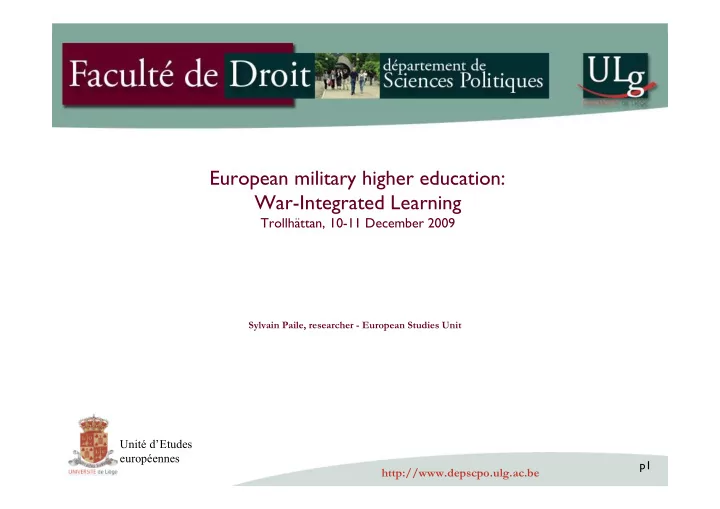

European military higher education: War-Integrated Learning Trollhättan, 10-11 December 2009 Sylvain Paile, researcher - European Studies Unit Unité d’Etudes européennes p1 http://www.depscpo.ulg.ac.be
Plan for the presentation: - (extensive) introduction: context of a study, definitions 1. The roots of the war-integrated learning 2. The extent of the principle - conclusions p2
Forewords: The European initiative for the exchange of young officers, inspired by Erasmus: -Exchanging knowledge, skills and competences among European military institutions; -Based on the experience of the educational institutions in terms of exchanges; -Not a duplication of Erasmus, but giving the tools to the institutions for easing their exchange projects (notably with regard to recognition)...Stocktaking; -The scope: « initial training/education » of a military officer p3
Definitions: - Initial training/education of an officer: preparation to the « first career », opposed to « advanced education ». But the definition is used pragmatically in the context of the Initiative for the exchange of young officers. Application Master + Bachelor Conscript service Leading a unit commissioning Formal definition Pragmatic (purposive) definition p4
- Military higher education : within the EU area, all initial educational systems of military officers are higher education - Academic education : knowledge, skills and competences that are taught in an academic way. Possibilities of self-studies and/or research. - Vocational training : the « vocation » of the cadets, practical training, including basic military training and professional training (including physical training) p5
Introduction: - The military specificity: job = war (in this context) - Training at work possible in civilian education, not in military - Solution found by the military education (understood as a concept): creating war-like situations - « Vaccin » effect Military education = war-integrated learning! p6
1. The roots of the war-integrated learning Internal roots: - Historically: training for fight, the « art of war » - Societal issues: loss of legitimacy - Social issues: downsizing the armed forces + reconversion p7
External causes: - The international context; - New missions...New needs...New people - Need to attract the adequate human resources...Choice of the intellectual excellence, the sciences of war - Will of integration of the military education into the European Higher Education Area p8
Results: - Integration of more and more academic education - Search for « university » shapes by the institutions - Supposedly, academic education > vocational education in weight, today. - Athens-Sparta: the shape of a new officer “Spartan” values “Athenian” values Personal austerity and glory Learning and high culture Discipline and self-sacrifice Creative and critical thinking Science and technology Philosophy and history Patriotism and honour Cross-cultural sympathies Personal heroism Politically post-heroic Source: Peter Foot, 2006 p9
A modern European officer needs to be both and needs to be trained through both academic and vocational instruction... p10
2. The extent of the principle: the organisation of the duality - In the facts, the academic and vocational aspects are always met (possible delegations of missions) - They are sometimes provided by different institutions (specialisation) - Attempt to measure the relative importance of these two dimensions in military education, the ratios. p11
p12
Remarks: - The methodology - The leadership training - The difficult distinction of the line between academic education and vocational training. - Possible impacts on the conduct of exchanges... p13
The raise of a military science? - « military science » = art of war (techniques of warfare + sciences of warfare) + thinking of war - coexistence of the two pillars or complete integration? Example of the time organisation / a curriculum Example of the scope of the Bologna certification: Inside? Outside? Accreditation? Quality assurance? Coexistence remains the principle within the EU... p14
Institutional implementation of the principle Many cases were found among the EU Member States: - Strict and institutional separation between the war-training and the academic education, example: Germany - Alternating academic and vocational periods, example: Belgium - Parallel organisation of the academic and vocational trainings (+alternation), example: Finland Also, mixed situations: - Institutional separation + alternation, example: Sweden (tomorrow’s presentation) - Institutional separation + parallel, example: United-Kingdom p15
Practical consequences For the Initiative, no impact on the possibilities of exchanges but impact on the organisation of this exchange, notably with regard to recognition Information about the socialisation in the military institutions: cadets or students or both? p16
Conclusions - The WIL principle’s analysis is fundamental when looking at the European initial military officers’ education - The dual organisation of this education trains to flexibility: understanding and reacting to the changes happening every day in the defence and security field - Lately, improvement of the academic dimension but the vocational one shall remain - A complex balance that is found in different ways within the EU - The interaction is sometimes problematic...recognition issue - « Initial » education...what about the « advanced » one? p17
Thank you for your attention! ...Questions? spaile@ulg.ac.be p18
Recommend
More recommend